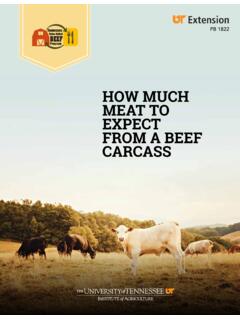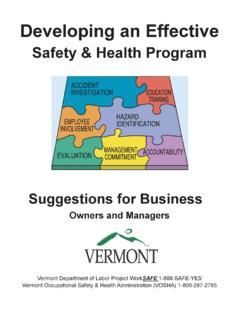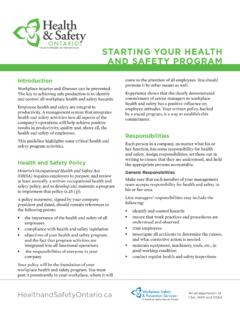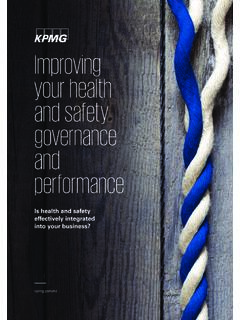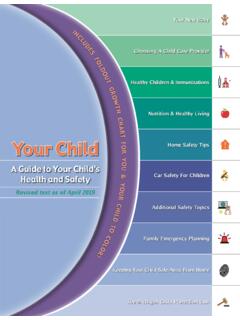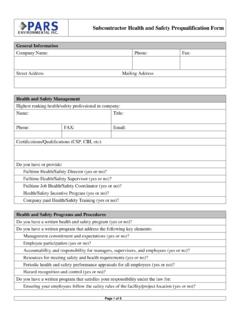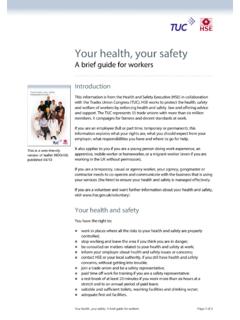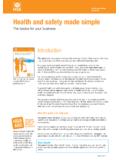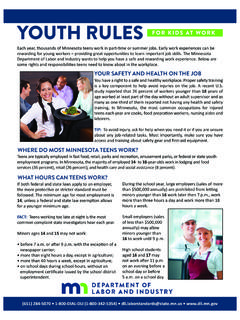Transcription of To Your Health Food Safety for Older Adults
1 W 317To your HealthFood Safety for Older Adults Table of ContentsFood Safety Crossword Puzzle ..4 What Do You Know About Foodborne Illness? ..5 food Safety Quiz ..5 Times Have Changed ..6Is It food or the Flu? ..7 You Have Changed ..7 The Five Basic Rules ..7 Wash Hands and Surfaces Often ..8 Avoid Cross-Contamination ..8 Cook Foods Adequately ..9 Apply the Heat ..10 Keep Foods at Safe Temperatures ..11 Refrigerator and Freezer Storage Chart ..13 Safe Thawing ..15 Avoid Foods From Unsafe Old Adults Are Advised Not to Eat ..16 Ready-to-Eat Foods ..16 Eating Out, Bringing In ..17 Reheating Foods Safely ..18An Ounce of Prevention ..18 Answers to Quiz and Crossword Puzzle ..184 ACROSS3. Always put cooked food on a _____ Fish is done when it _____ with a Foodborne illness can be mistaken for Temperature range between 40 F and 140 F in which bacteria grow rapidly.
2 (2 words)8. Cook eggs until they are These foods may have bacteria that cause Store raw ground meat _____ raw vegetables in your To prevent foodborne illness, keep foods at safe _____ .15. What should you use to check the internal temperature of a food ?17. Keep food _____ to Foodborne illness is a newer term for food _____ .23. Refrigerate leftover foods in what kinds of containers?DOWN1. To prevent cross-contamination, you should _____ some _____ can be passed from one person to another due to poor personal Mix this with water for an inexpensive sanitizer. (2 words)4. One source of Eschericia coli is _____ ground These should be heated to 165 Frozen foods should be thawed in the what?13. This system weakens as we For how many minutes should you wash your hands?18. Temperature at which your refrigerator should be Foods can be frozen in This is often a symptom of foodborne Cooked foods should be at room temperature no longer than _____ Safety Crossword Puzzle 5An ounce of prevention is worth a pound of your Health !
3 food Safety for Older AdultsJanie BurneyProfessorFamily and Consumer SciencesYou ve had a lot of experience buying and preparing food . Studies show that Older Adults do a better job of handling food safely than other age groups. So, why do you need to be concerned about food Safety ? We all need to be more careful with foods because where and how we produce our foods has changed. In addition, your ability to resist foodborne illness has probably changed as you have gotten do you know about foodborne illness? food poisoning, or what is now called foodborne illness, can be a serious problem for Older Adults . It s important that you know how to prevent illness from the food you eat. See how much you know by answering the questions on the food Safety Quiz. Answers are given on page 18 of this Safety Quiz1. How many people get foodborne illness in the United States each year?
4 A. 1 in 6 b. 1 in 10 c. 1 in 202. How long does it take to become sick after eating harmful bacteria in food ?a. 2 hoursb. 24 hours c. 20 minutes to 6 weeks6 Today, food in yourgrocery store comes fromall over the Cooking food to a safe temerature kills bacteria that can make you Trueb. False4. Which of the following people are more likely to get foodborne illness?a. People over 65b. Teenagersc. Young adults5. At what temperature should you set your refrigerator?a. 40 Fb. 50 Fc. 60 FTimes Have ChangedThe way we grow, purchase and prepare our food has changed. People used to grow food close to home. You probably bought food from a local farmer and prepared it in your kitchen. Now your food comes from across the country and across the world. Today people eat more food prepared away from home. These changes have increased your risk for foodborne illness.
5 We also know more about bacteria in food than we did a few years ago. Before outbreaks of Escherichia coli 0157:H7, we knew little about the risks of eating undercooked ground meat. Today we know that some kinds of illnesses you normally do not associate with food , such as arthritis, may be caused by harmful bacteria in food . Older Adults are more likely to get sick from harmful bacteria in food compared to other age groups. Once they become sick, they are more likely than others to have serious Health problems. Why are Older Adults more susceptible to foodborne illness? As we age, our immune systems weaken and the amount of acid our stomachs produce decreases. Stomach acid helps reduce the number of bacteria in our intestinal tracts. With age we also are more likely to develop chronic diseases, such as diabetes and cancer, that lower immunity.
6 Medications, such as anti-inflammatory drugs, also suppress the immune system. These factors decrease the ability to prevent infection and increase the chances of serious complications. 7 You can become sick anytime from 20 minutes to six weeks after it food or the Flu?Experts believe 48 million people or more develop foodborne illness each year in the United States. It s very possible that even more people become sick from food because it often goes unreported or is mistaken for the flu. The symptoms of foodborne illness and how quickly you become sick depend on the type of bacteria and how much you ingest. Symptoms of foodborne illness commonly involve the gastrointestinal tract. Whereas abdominal pain, vomiting and diarrhea are common complaints with foodborne illness, respiratory problems, such as cough and chest congestion, are common symptoms of the flu.
7 However, you can have flu-like symptoms, such as fever, headache and body aches, with foodborne Have ChangedHow soon you become ill after you have eaten can vary from 20 minutes to six weeks. Usually, it takes bacteria one to three days to make you feel sick. You can t see, smell or taste harmful bacteria in food , and sometimes you don t know if it s the flu or something you ve eaten. The only way you can be sure is to see a doctor for tests. If you suspect you are ill from food , it is best to see a doctor, especially when symptoms are severe. This can prevent the development of more serious Health Five Basic RulesDespite how things have changed, you can feel safe eating food in the United States. We have one of the safest food supplies in the world. However, how you handle food is important. food Safety experts recommend following these basic rules: Wash hands and surfaces often.
8 Avoid cross-contamination. Cook foods adequately. Keep foods at safe temperatures. Avoid foods from unsafe 1 Wash hands and surfaces oftenRule 2 Avoid cross-contaminationWash Hands and Surfaces OftenSafe food handling begins with personal hygiene. Individuals infected with bacteria or viruses can pass them to others through food , particularly foods that require no further cooking. Here s how to avoid passing germs to others when preparing food . Wash your hands with warm running water and soap for about 20 seconds before handling food . Wash after using the bathroom, changing diapers and handling pets. Always rinse well and dry hands on a clean or disposable towel. Avoid preparing food for others if you are ill with diarrhea. Cover cuts and burns on your hands with clean bandages and gloves when handling food .
9 Handle foods with utensils rather than your hands when possible. Wash cutting boards, dishes, utensils and counter tops with hot water and Cross-ContaminationCross-contamination happens when bacteria spread from one food to another. It can be prevented by keeping foods that may have harmful bacteria, such as raw meat, poultry and seafood, away from other foods. These foods and their juices should not touch foods that will not be cooked. Here s how to avoid the spread of bacteria by cross-contamination. Wash your counter tops, cutting boards, dishes and utensils with hot water and soap after they have come in contact with raw meat, poultry and seafood. After washing and rinsing, sanitize with 1 teaspoon of chlorine bleach mixed with 1 quart of clean water. Change dishcloths and cloth towels often and wash them in the hot cycle of your washing machine.
10 Dry sponges, dishcloths and towels thoroughly after each use, and wash them often. Air-dry dishes, or consider using paper towels. Replace worn cutting boards that have hard-to-clean grooves with newer boards. 9 Separate raw meat,poultry and seafoodfrom other foods. Rinse produce in clean water. Use a vegetable brush if necessary to remove soil, but don t use soap or detergents. Separate raw meat, poultry and seafood from other foods in your grocery-shopping cart, shopping bags and in your refrigerator. Place cooked food on clean Foods AdequatelyCooking food long enough at a high enough temperature will kill harmful bacteria. Here s how to avoid foodborne illness from undercooked food . Cook foods until they reach the safe temperatures shown in the table, Apply the Heat. Use a clean food thermometer to measure the internal temperature of a cooked food .

